
DON’T TELL ED POINSETTIAS AREN’T PERENNIALS IN HOUSTON!
By BRENDA BEUST SMITH
DECADES AGO I wrote, in my Houston Chronicle Lazy Gardener column about poinsettias — something to the effect that if you’re feeling lucky, in spring plant your fading poinsettias in the garden. But don’t have high expectations.
Immediate note came in from reader ED HOLLAND, with pictures of his beautiful poinsettia SHRUBS growing under pine trees in his Memorial area landscape. Even back then they were 5′ tall and rebloomed year after year!
Above is Ed’s this year’s — current! — bloom display. As I was back then, I am still awed. And ever since then, I periodically report to readers on his STILL- LIVING poinsettias which have now expanded with growth and planted cuttings to the beautiful spreads above!
Ed’s secret: He cuts the plants back severely in February and roots the trimmings. He mulches all, plants and trimmings, adding . . . “I am starting now to forage neighbors bagged lawn clippings that have been through a mower for mulch. I use Microlife which is more of a soil amendment than fertilizer.”

Learn the proper mulch, compost, and other aids the tree prefers.
Know the difference between an inactive (dormant) tree and one that is dead BEFORE leaf fall. When a tree in your landscape has no leaves this winter, it can be hard to tell.
Correctly mulching can help retain soil moisture, provide organic matter to soil, help reduce erosion, help regulate soil temperature, and more. Choose the right mulch, apply the correct amount (far enough out!), be sure you buy enough and reapply as needed. (Note: more safe mulching advice in John’s column below!)
Quality compost adds nutrients and organic matter to soil, improving soil biology in a way synthetic fertilizers can’t.
Know your trees’ water needs! Base watering on soil conditions instead of a set schedule. Evergreens are still active during the winter and still need water. Snow, while it is water, isn’t available to trees until it melts. Even evergreens surrounded by snow could still need water. Again, check soil conditions.
Adjust how you water. If your summer was hot, long, and dry like ours was, you may have watered more to compensate. Now that temps are colder and weather might be wetter, your trees might need less supplemental watering. Overwatering is more common than underwatering. and can lead to a number of problems.
Don’t plant in wet soil any time of the year. Planting trees in wet soil can lead to a poor installation among other problems.
Plan ahead with plastic sheeting — and ways to prop/secure it — when temps go below freezing. (Or below a specific tree’s tolerance level.) Prepare a space to shelter potted trees during freezes. Apply quality mulch properly around trees to help regulate soil temperature.
Know when it’s best to call the pros (if you can afford it, doing it right is safer for both you and your trees!):
Pruning – The dormant season can be a good time to prune/have pruned certain types of trees to get rid of damaged, diseased, or dead branches. This can help reduce problems from ice and snow.
Winter feeding – Different types of trees benefit from deep root fertilization and other types of feeding during the winter.
Cabling and bracing – In some situations a tree might need additional protection during winter to help with snow or ice accumulation. Cabling or bracing could help — a professional arborist can help determine if it is right for your trees.
Next fall (too late now), watch for tops of trees that shed leaves faster than the rest of the same tree. This might signal a problem a professional should check out.
* * *
EDITOR’S NOTE TO CLUBS. ArborTrue’s Brittany Bates, an ISA Certified Arborist, is available as a club speaker. brittanybates@arbortrue.com.
* * *
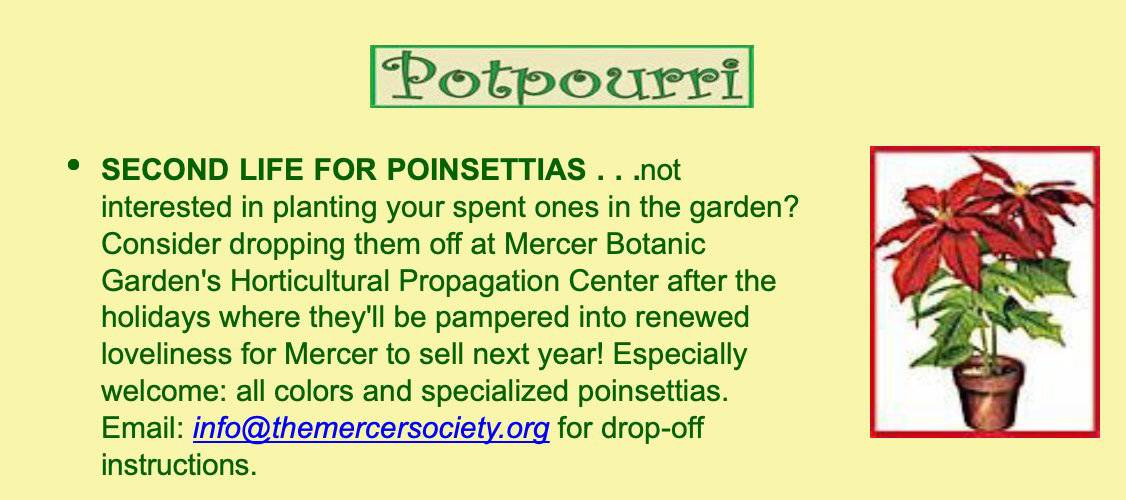
JAN. 8, 2024, WILL BE A VERY SPECIAL MERCER BOTANIC GARDEN
CELEBRATION, a great day to visit, see what could be blooming in your garden and help celebrate its 50th Anniversary! My family utilized Mercer even before it became a great Houston public treasure, a tale I’ll share during this 9am-noon salute. Do join us! Details: .facebook.com/MercerBotanicGardens/
PLANT IT FORWARD Normally this column is aimed at home gardeners. But a unique group here, among other horticultural contributions, aims at refugee economic inclusion. Interested in expanding to horizons beyond your own borders? Plant It Forward is adding two ground breaking
additions to its Farm Education Program.
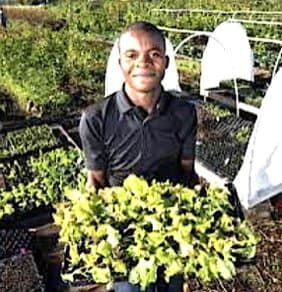
A (paid) Apprenticeship and Short Course series are open to ANY interested participant, and are free for those with an immigrant/refugee background. plantitforward.farm/farms/?mc_cid=a2836a18a6&mc_eid=831db5e81f#prospective
* * *
Brenda Beust Smith’s column is based on her 40+ years as
Houston Chronicle’s Lazy Gardener — Email: lazygardenerbrenda@gmail.com Note: This column focuses ONLY on the Greater Houston area.
* * *

NEWS FROM THE WONDERFUL WORLD OF SOIL AND PLANTS # 267
Subject: fire danger of mulch warning signs of a bad mulch
The excellent tree company Arbor True shared an article above about tree care for winter and mentioned mulches several times.
Something most of us do not think about is Fire Danger from our mulch. This time of year, fires are in fireplaces, fire pits, barbeque pits and many other possible sources.
Over the last few years there have been a lot of wildfires in the USA and thousands of homes destroyed (ex. Bastrop, Texas 2011). Fires in California and Canada this past year to name a few.
In many cases it was not the roof that caught fire, but the mulch in the landscape. The mulch ignited and then carried the fire to the house.
Often mulch is set on fire by still burning embers from forest or grass fires brought in by the wind, cigarettes are a common ignition source, lightning is a possible source, static electricity and even a broken bottles can focus the sunlight and cause a fire.
Known Fire Ignition Sources
Cigarettes
Sparks (fireplace, bar-b-que pit, fire pit) Embers (burning house or wildfire) Lightning
Static Electricity
Wiring (electrical shorts)
Reflected heat from low-E windows Matches and lighters
Broken bottles Spontaneous
Sparks from accidents
How often do we see scenes like this where cigarettes are dumped on a highly flammable mulch? This shredded mulch was a vey poor choice since it is near a smoking area.

Below is an example of how an ember could catch the easily flammable dyed mulch on fire, which could then catch the fence on fire and travel to the house.
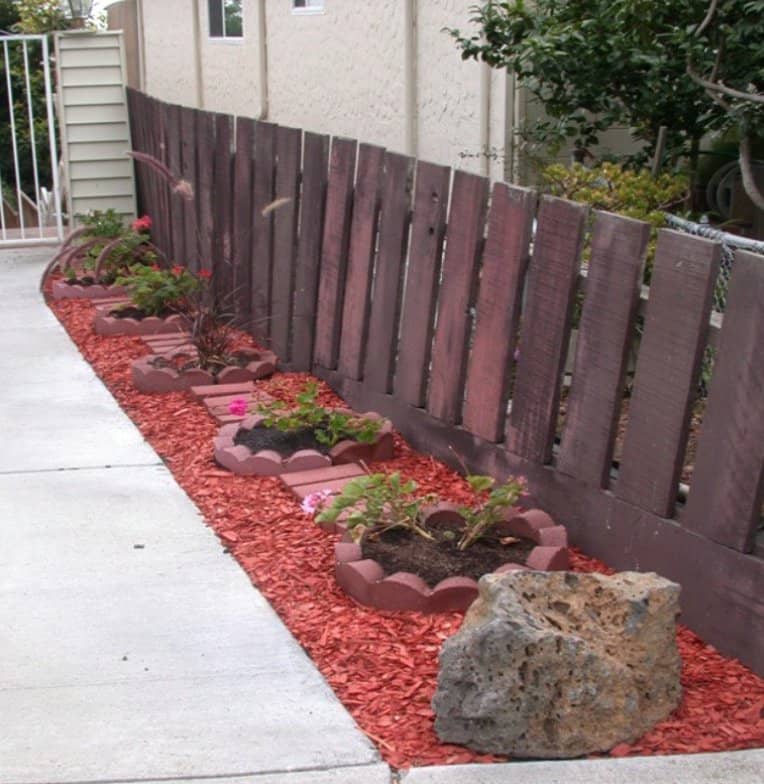
As a result of all the homes that were burned, several universities decided to study the flammability of mulches and how they might contribute to house fires.
They used a Propane Torch and fifteen seconds of intense heat and flame were applied to each mulch sample then the torch removed. The tests were performed one year after installation of mulch.
Some of the things that were discovered were surprising, as even some of the organic mulches would not ignite.
Just using a match (no propane torch), the ignition of Rubber Chipped Mulch occurred every time.
Fire in chipped rubber mulch which is made from recycled tires, gave off toxic fumes, could not be extinguished with water (water spreads the flames and makes it worse). It required extinguishing by beating out with a shovel or special chemical foams that are toxic themselves.
Tests from the demonstrations found that the Dyed and Shredded Hardwood Mulch caught fire every time. The chart below lists the other results.
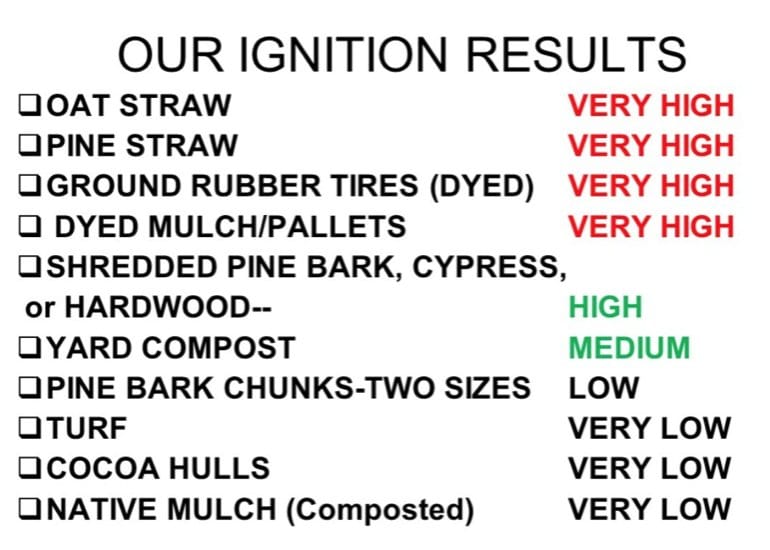
Some of the slides and data were from studies on mulch and fire conducted by the University of Nebraska and the University of Florida.
I often hear of folks commenting that the mulch they purchased stinks. Warning Signs of a Bad Mulch
ODORS: Odors are warning signs of low quality and potentially dangerous mulches and composts.
- Anaerobic organic acids that have a strong odor from the putrefying
organic matter. The odor varies depending on feedstock or material and what is going on, however they are all very bad. Plant roots are very sensitive to alcohols as little as 1 ppm will kill most plant roots. A few common ones are:
Acetic acid – vinegar smell, loss of nitrogen and phosphorous, alcohols present Butyric acid – sour milk smell, alcohols present
Valeric acid – vomit smell, alcohols present Putrescine – rotting meat smell, alcohols present
- Ammonia – implies an immature compost or mulch which will be phytotoxic, and the nitrogen is being lost to the air.
- Rotten egg (H2S) – implies an immature compost or mulch which is phytotoxic, and signals a loss of the nutrient sulfur.
* * *
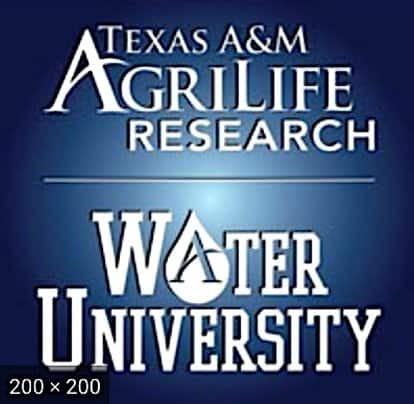
SPONSORSHIP
If you are interested in becoming a sponsor, please contact us at 936-273-1200 or send an e-mail to: lazygardenerandfriends@gmail.com

ABOUT US
BRENDA BEUST SMITH WE KNOW HER BEST AS THE LAZY GARDENER . . . but Brenda Beust Smith is also:
- a national award-winning writer & editor
- a nationally-published writer & photographer
- a national horticultural speaker
- a former Houston Chronicle reporter
When the Chronicle discontinued Brenda’s 45-year-old Lazy Gardener” print column — started in the early ’70s as a fun side-project to reporting, it then ranked as the longestrunning, continuously-published local newspaper column in the Greater Houston area. The name, she says, is not just fun, it’s true. Brenda’s gradual sideways step from reporter into gardening writing led first to an 18-year series of when-to-do-what Lazy Gardener Calendars, then to her Lazy Gardener’s Guide book which morphed into her Lazy Gardener’s Guide on CD, which she now emails free upon request. Brenda became a Harris County Master Gardener and, over the years, served on theboards of many Greater Houston area horticulture organizations. She hosted local radio and TV shows, most notably a 10+-year Lazy Gardener specialty shows on HoustonPBS (Ch. 8) and her call-in “EcoGardening” show on KPFT-FM. For over three decades, Brenda served as Assistant Production Manager of the GARDEN CLUB OF AMERICA’S “BULLETIN” magazine. Although still an active broad-based freelance writer, Brenda’s main focus now is THE LAZY GARDENER & FRIENDS HOUSTON GARDEN NEWSLETTER with John Ferguson and Pablo Hernandez of Nature’s Way Resources. A native of New Orleans and graduate of St. Agnes Academy and the University of Houston, Brenda lives in Humble, TX, and is married to the retired Aldine High School Coach Bill Smith. They have one son, Blake. Regarding this newsletter, Brenda is the lead writer, originator of it and the daily inspiration for it. We so appreciate the way she has made gardening such a fun way to celebrate life together for such a long time.
JOHN FERGUSON John is a native Houstonian and has over 27 years of business experience. He owns Nature’s Way Resources, a composting company that specializes in high quality compost, mulch, and soil mixes. He holds a MS degree in Physics and Geology and is a licensed Soil Scientist in Texas. John has won many awards in horticulture and environmental issues. He represents the composting industry on the Houston-Galveston Area Council for solid waste. His personal garden has been featured in several horticultural books and “Better Homes and Gardens” magazine. His business has been recognized in the Wall Street Journal for the quality and value of their products. He is a member of the Physics Honor Society and many other professional societies. John is is the co-author of the book Organic Management for the Professional. For this newsletter, John contributes articles regularly and is responsible for publishing it.
PABLO HERNANDEZ Pablo Hernandez is the special projects coordinator for Nature’s Way Resources. His realm of responsibilities include: serving as a webmaster, IT support, technical problem solving/troubleshooting, metrics management and quality control. Pablo helps this newsletter happen from a technical support standpoint.
Download the Newsletter with Our Events Calendar Below!

